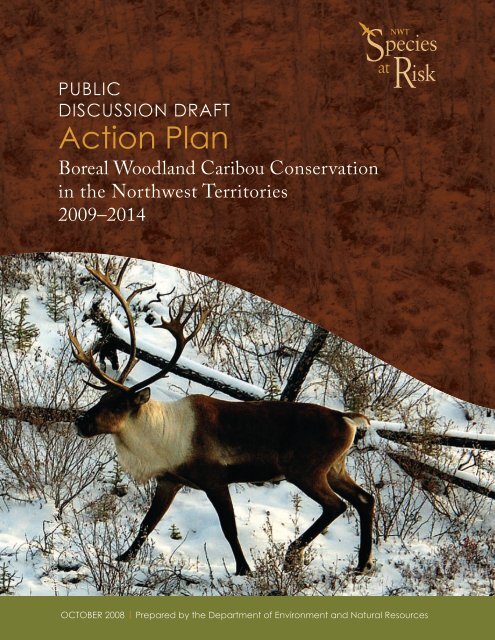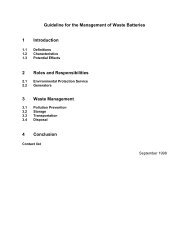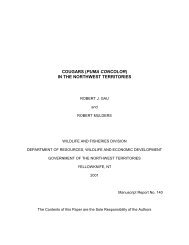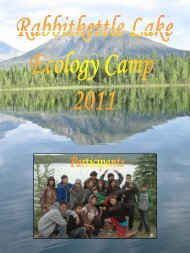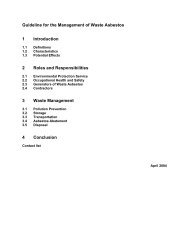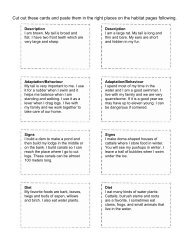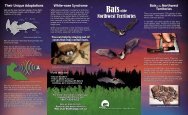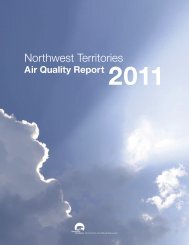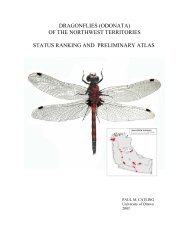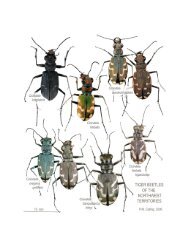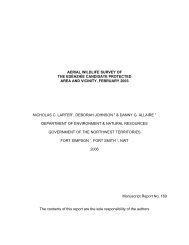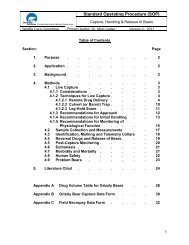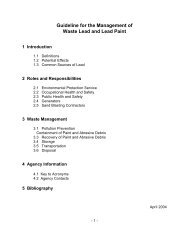Boreal Caribou Conservation in the NWT - Environment and Natural ...
Boreal Caribou Conservation in the NWT - Environment and Natural ...
Boreal Caribou Conservation in the NWT - Environment and Natural ...
Create successful ePaper yourself
Turn your PDF publications into a flip-book with our unique Google optimized e-Paper software.
PUBLIC<br />
DISCUSSION DRAFT<br />
Action Plan<br />
<strong>Boreal</strong> Woodl<strong>and</strong> <strong>Caribou</strong> <strong>Conservation</strong><br />
<strong>in</strong> <strong>the</strong> Northwest Territories<br />
2009–2014<br />
photo by John Nagy<br />
OCTOBER 2008 | Prepared by <strong>the</strong> Department of <strong>Environment</strong> <strong>and</strong> <strong>Natural</strong> Resources
av<br />
We still want to hear from YOU!<br />
Biologists from <strong>Environment</strong> <strong>and</strong> <strong>Natural</strong> Resources held<br />
meet<strong>in</strong>gs with wildlife co-management boards <strong>and</strong> <strong>in</strong><br />
almost every community <strong>in</strong> <strong>the</strong> Northwest Territories (<strong>NWT</strong>)<br />
to provide elders, community members <strong>and</strong> organizations<br />
an opportunity to have <strong>in</strong>put <strong>in</strong>to <strong>the</strong> Action Plan for<br />
<strong>Boreal</strong> Woodl<strong>and</strong> <strong>Caribou</strong> <strong>Conservation</strong> <strong>in</strong> <strong>the</strong> Northwest<br />
Territories. Twenty-three specific actions have been<br />
identified to help conserve boreal caribou <strong>and</strong> <strong>the</strong> Action<br />
Plan is now ready for public review.<br />
There is still time to make your op<strong>in</strong>ions heard <strong>and</strong> answer<br />
<strong>the</strong> follow<strong>in</strong>g questions:<br />
• Are <strong>the</strong>se goals appropriate for <strong>the</strong> conservation of<br />
boreal caribou <strong>in</strong> <strong>the</strong> <strong>NWT</strong>?<br />
• Do <strong>the</strong>se actions address <strong>the</strong> threats fac<strong>in</strong>g boreal<br />
caribou <strong>in</strong> <strong>the</strong> <strong>NWT</strong>?<br />
By December 31, 2008, please contact your local<br />
<strong>Environment</strong> <strong>and</strong> <strong>Natural</strong> Resources office or:<br />
Director, Wildlife Division<br />
Department of <strong>Environment</strong> <strong>and</strong> <strong>Natural</strong> Resources<br />
Government of <strong>the</strong> Northwest Territories<br />
P.O. Box 1320, 5th Floor Scotia Centre<br />
Yellowknife, NT X1A 2L9<br />
Tel: (867) 920-8064<br />
Fax: (867) 873-0293<br />
E-mail: speciesatrisk_borealcaribou@gov.nt.ca<br />
Visit: www.nwtwildlife.com<br />
action plan for boreal woodl<strong>and</strong> caribou conservation <strong>in</strong> <strong>NWT</strong> | public discussion draft | october 2008<br />
1
Introduction<br />
The Action Plan for <strong>Boreal</strong> Woodl<strong>and</strong> <strong>Caribou</strong> <strong>Conservation</strong> <strong>in</strong><br />
<strong>the</strong> Northwest Territories conta<strong>in</strong>s general goals <strong>and</strong> direction<br />
for conservation of <strong>the</strong> boreal population of woodl<strong>and</strong> caribou<br />
(boreal caribou) <strong>in</strong> <strong>the</strong> <strong>NWT</strong>. The purpose of this Action Plan is<br />
to outl<strong>in</strong>e actions management authorities <strong>in</strong> <strong>the</strong> <strong>NWT</strong> can take<br />
to help conserve boreal caribou. These actions are based on<br />
<strong>the</strong> best traditional, local <strong>and</strong> scientific knowledge available<br />
<strong>and</strong> are subject to change to accommodate new <strong>in</strong>formation<br />
<strong>and</strong> objectives. The actions identified <strong>in</strong> this document support<br />
<strong>the</strong> 16th <strong>NWT</strong> Legislative Assembly’s goal of “an environment<br />
that will susta<strong>in</strong> present <strong>and</strong> future generations” <strong>and</strong> priority to<br />
“coord<strong>in</strong>ate our efforts to ensure development is susta<strong>in</strong>able<br />
for our l<strong>and</strong> <strong>and</strong> wildlife”. Implementation of <strong>the</strong>se actions<br />
is subject to <strong>the</strong> priorities <strong>and</strong> budgetary constra<strong>in</strong>ts of <strong>the</strong><br />
management authorities.<br />
action plan for boreal woodl<strong>and</strong> caribou conservation <strong>in</strong> <strong>NWT</strong> | public discussion draft | october 2008<br />
3
Goals<br />
Recogniz<strong>in</strong>g that boreal caribou, like o<strong>the</strong>r wildlife, are<br />
ecologically, culturally <strong>and</strong> spiritually valued <strong>in</strong> <strong>the</strong> <strong>NWT</strong>, <strong>the</strong><br />
goals for <strong>the</strong> conservation of boreal caribou are to:<br />
1. Prevent boreal caribou from becom<strong>in</strong>g a species at risk 1 <strong>in</strong><br />
<strong>the</strong> <strong>NWT</strong> as a result of human activities.<br />
2. Ma<strong>in</strong>ta<strong>in</strong> <strong>the</strong> current contiguous distribution of boreal caribou<br />
<strong>in</strong> <strong>the</strong> <strong>NWT</strong>, for <strong>the</strong> benefit of all <strong>NWT</strong> residents <strong>and</strong> future<br />
generations.<br />
3. Manage boreal caribou as envisioned <strong>in</strong> <strong>the</strong> Recovery<br />
Strategy for <strong>the</strong> Woodl<strong>and</strong> <strong>Caribou</strong> <strong>Boreal</strong> Population, <strong>in</strong><br />
Canada (<strong>Environment</strong> Canada, <strong>in</strong> prep.) <strong>and</strong> to contribute<br />
to <strong>the</strong> biodiversity of <strong>the</strong> <strong>NWT</strong>.<br />
Implications of <strong>the</strong>se goals are:<br />
1. To ma<strong>in</strong>ta<strong>in</strong> <strong>the</strong> current distribution <strong>and</strong> habitats of boreal<br />
caribou we need to manage natural <strong>and</strong> human impacts at<br />
<strong>the</strong> l<strong>and</strong>scape level.<br />
2. The scale <strong>and</strong> extent of development activities may have to<br />
be regulated or managed to ma<strong>in</strong>ta<strong>in</strong> effective habitat for<br />
boreal caribou <strong>in</strong> perpetuity, <strong>in</strong>clud<strong>in</strong>g habitat connectivity.<br />
3. A better underst<strong>and</strong><strong>in</strong>g of <strong>the</strong> comb<strong>in</strong>ed effects of natural<br />
<strong>and</strong> human impacts <strong>and</strong> predation (<strong>in</strong>clud<strong>in</strong>g harvest) on<br />
boreal caribou population dynamics is needed.<br />
4. <strong>Boreal</strong> caribou harvest monitor<strong>in</strong>g <strong>and</strong> predator<br />
management may be required <strong>in</strong> some areas to ma<strong>in</strong>ta<strong>in</strong><br />
self-susta<strong>in</strong><strong>in</strong>g boreal caribou populations.<br />
5. Population trends for boreal caribou will have to be<br />
determ<strong>in</strong>ed to ensure population numbers rema<strong>in</strong> with<strong>in</strong> <strong>the</strong><br />
natural range of variation.<br />
6. The conservation of boreal caribou <strong>in</strong> <strong>the</strong> <strong>NWT</strong> can only be<br />
achieved with <strong>the</strong> cooperation <strong>and</strong> support of First Nations,<br />
<strong>NWT</strong> wildlife co-management boards, <strong>the</strong> Tåîchô Government<br />
<strong>and</strong> <strong>NWT</strong> residents.<br />
4<br />
1 <br />
Accord<strong>in</strong>g to <strong>the</strong> Committee on <strong>the</strong> Status of Endangered Wildlife <strong>in</strong> Canada<br />
(COSEWIC), a species may be determ<strong>in</strong>ed at risk if <strong>the</strong>re is a decl<strong>in</strong><strong>in</strong>g total population<br />
over three generations or 10 years, whichever is longer, OR a small distribution with a<br />
decl<strong>in</strong>e or fluctuation <strong>in</strong> numbers, OR a small total population size with a decl<strong>in</strong>e <strong>in</strong><br />
number, OR a very small or restricted number of mature <strong>in</strong>dividuals with a restricted<br />
area of occupancy <strong>and</strong> o<strong>the</strong>r factors. There are more specific criteria that accompany<br />
<strong>the</strong>se provisos. Consult www.cosewic.gc.ca for more details.<br />
action plan for boreal woodl<strong>and</strong> caribou conservation <strong>in</strong> <strong>NWT</strong> | public discussion draft | october 2008
Background<br />
<strong>Boreal</strong> caribou exist across much of Canada. Habitat loss <strong>and</strong><br />
reduced distribution <strong>in</strong> sou<strong>the</strong>rn Canada contributed to <strong>the</strong><br />
federal government list<strong>in</strong>g boreal caribou as Threatened under<br />
<strong>the</strong> federal Species at Risk Act.<br />
Although <strong>the</strong> federal list<strong>in</strong>g of boreal caribou applies throughout<br />
Canada, boreal caribou <strong>in</strong> <strong>the</strong> <strong>NWT</strong> are not considered to<br />
be currently at risk. The <strong>NWT</strong> General Status Rank<strong>in</strong>g Program<br />
ranked boreal caribou as “Sensitive”. This designation is for<br />
species that are not at risk of ext<strong>in</strong>ction or extirpation but may<br />
require special attention or protection to prevent <strong>the</strong>m from<br />
becom<strong>in</strong>g “At Risk” 2 . Based on traditional knowledge <strong>and</strong><br />
scientific studies, <strong>the</strong>re are an estimated 6,000 to 7,000 boreal<br />
caribou <strong>in</strong> <strong>the</strong> <strong>NWT</strong>, which still occupy much of <strong>the</strong>ir historic range.<br />
Because of <strong>the</strong> federal list<strong>in</strong>g, a national Recovery Strategy<br />
for <strong>the</strong> Woodl<strong>and</strong> <strong>Caribou</strong>, <strong>Boreal</strong> Population, <strong>in</strong> Canada<br />
(<strong>Environment</strong> Canada, <strong>in</strong> prep.) was developed. Each<br />
jurisdiction <strong>in</strong> Canada with boreal caribou (<strong>the</strong> <strong>NWT</strong>, along with<br />
British Columbia, Alberta, Saskatchewan, Manitoba, Ontario,<br />
Quebec <strong>and</strong> Newfoundl<strong>and</strong>-Labrador) helped develop this<br />
recovery strategy <strong>and</strong> made a commitment to develop <strong>and</strong><br />
implement <strong>the</strong>ir own Recovery Strategies or Action Plans to<br />
address specific boreal caribou recovery or<br />
management concerns <strong>in</strong> <strong>the</strong>ir jurisdiction.<br />
Northwest<br />
Territories<br />
Yukon<br />
In <strong>the</strong> Northwest Territories<br />
boreal caribou are found<br />
throughout <strong>the</strong> boreal forest of<br />
<strong>the</strong> Mackenzie River bas<strong>in</strong>.<br />
British<br />
Columbia<br />
Alberta<br />
Saskatchewan<br />
Manitoba<br />
2 <br />
Consult <strong>the</strong> <strong>NWT</strong> Species Monitor<strong>in</strong>g Infobase for more details:<br />
www.nwtwildlife.com/ENR_Infobas/asp/Search.asp<br />
action plan for boreal woodl<strong>and</strong> caribou conservation <strong>in</strong> <strong>NWT</strong> | public discussion draft | october 2008<br />
5
6<br />
Photo by Boyan Tracz Photo by Richard Popko Photo by Mike Bly<br />
Threats<br />
To help identify threats to boreal caribou <strong>in</strong> <strong>the</strong> <strong>NWT</strong>, <strong>and</strong><br />
actions to address those threats, meet<strong>in</strong>gs were held<br />
with wildlife co-management boards <strong>and</strong> <strong>in</strong> almost every<br />
community <strong>in</strong> <strong>the</strong> <strong>NWT</strong>. The threats identified <strong>in</strong>cluded:<br />
• Direct loss of habitat through l<strong>and</strong>scape change result<strong>in</strong>g<br />
from human activities;<br />
• L<strong>and</strong>scape changes caused by wildfire <strong>and</strong> o<strong>the</strong>r natural<br />
disturbances;<br />
• Avoidance or reduced use of specific areas of habitat as a<br />
result of disturbances caused by human activities;<br />
• Vehicle collisions;<br />
• Parasites <strong>and</strong> disease;<br />
• Predation, <strong>in</strong>clud<strong>in</strong>g changes <strong>in</strong> <strong>the</strong> numbers <strong>and</strong> densities of<br />
predators <strong>and</strong> alternate prey species; <strong>and</strong><br />
• Harvest<strong>in</strong>g.<br />
action plan for boreal woodl<strong>and</strong> caribou conservation <strong>in</strong> <strong>NWT</strong> | public discussion draft | october 2008
Recommended Tools <strong>and</strong> Actions<br />
to Address Threats<br />
A. Population Monitor<strong>in</strong>g <strong>and</strong> Management<br />
At almost every community meet<strong>in</strong>g about boreal caribou <strong>in</strong><br />
<strong>the</strong> <strong>NWT</strong>, people supported cont<strong>in</strong>ued monitor<strong>in</strong>g of boreal<br />
caribou populations. Population monitor<strong>in</strong>g is needed to guide<br />
management decisions <strong>and</strong> generate data on boreal caribou<br />
ecology.<br />
Action 1<br />
Establish long-term monitor<strong>in</strong>g (repeated efforts over multiple<br />
years) of adult female mortality <strong>and</strong> calf survival to determ<strong>in</strong>e<br />
whe<strong>the</strong>r local boreal caribou numbers are <strong>in</strong>creas<strong>in</strong>g,<br />
decreas<strong>in</strong>g or stable. This may <strong>in</strong>clude putt<strong>in</strong>g radio, satellite or<br />
GPS collars on adult cows.<br />
Action 2<br />
In areas of <strong>the</strong> <strong>NWT</strong> where development is occurr<strong>in</strong>g <strong>and</strong><br />
where specific boreal caribou range management plans are<br />
be<strong>in</strong>g developed, monitor <strong>the</strong> harvest to ensure boreal caribou<br />
populations rema<strong>in</strong> susta<strong>in</strong>able (see Action 5).<br />
Action 3<br />
In cooperation with harvesters, collect samples <strong>and</strong> comments<br />
(a piece of hide from <strong>the</strong>ir harvest, along with location, sex,<br />
numbers seen) <strong>and</strong> establish ongo<strong>in</strong>g DNA analyses to better<br />
underst<strong>and</strong> how boreal caribou use <strong>the</strong> l<strong>and</strong>scape.<br />
Action 4<br />
Determ<strong>in</strong>e <strong>and</strong> monitor boreal caribou population trends <strong>in</strong><br />
each settlement region <strong>and</strong>/or <strong>in</strong> each area identified <strong>in</strong> Action<br />
7. The current population estimate for boreal caribou <strong>in</strong> <strong>the</strong> <strong>NWT</strong><br />
was derived us<strong>in</strong>g density estimates obta<strong>in</strong>ed <strong>in</strong> study areas<br />
where all boreal caribou were observed while track<strong>in</strong>g radiocollared<br />
caribou or were counted dur<strong>in</strong>g aerial surveys. These<br />
density estimates were used to estimate <strong>the</strong> number of caribou<br />
<strong>in</strong> all regions with<strong>in</strong> <strong>the</strong> range of boreal caribou <strong>in</strong> <strong>the</strong> <strong>NWT</strong>.<br />
Photo by John Nagy<br />
Photo by John Nagy<br />
action plan for boreal woodl<strong>and</strong> caribou conservation <strong>in</strong> <strong>NWT</strong> | public discussion draft | october 2008<br />
7
B. Habitat Plann<strong>in</strong>g <strong>and</strong> Management<br />
<strong>Environment</strong> <strong>and</strong> <strong>Natural</strong> Resources monitors natural habitat<br />
changes <strong>and</strong> disturbances associated with climate change<br />
<strong>and</strong> will cont<strong>in</strong>ue to do so. The implications of climate change<br />
will be worked <strong>in</strong>to actions when appropriate <strong>and</strong> as new<br />
<strong>in</strong>formation becomes available. A chang<strong>in</strong>g climate may have<br />
unforeseen effects on boreal caribou habitats <strong>and</strong> populations<br />
<strong>and</strong> may result <strong>in</strong> changes nor<strong>the</strong>rn regulators <strong>and</strong> managers<br />
have little to no ability to control.<br />
The Action Plan for <strong>Boreal</strong> Woodl<strong>and</strong> <strong>Caribou</strong> <strong>Conservation</strong> <strong>in</strong><br />
<strong>the</strong> Northwest Territories takes a l<strong>and</strong>scape perspective. Many<br />
communities, particularly <strong>in</strong> <strong>the</strong> South Slave <strong>and</strong> Dehcho Regions,<br />
know of areas that are important for boreal caribou (i.e.<br />
Cameron Hills) <strong>and</strong> underst<strong>and</strong> l<strong>and</strong>scape changes caused<br />
by wildfires or human activities, <strong>in</strong>clud<strong>in</strong>g <strong>in</strong>dustry, could affect<br />
boreal caribou. Traditional knowledge <strong>and</strong> scientific studies<br />
have shown that boreal caribou <strong>in</strong> <strong>the</strong> <strong>NWT</strong> need large areas of<br />
suitable habitat to range over. To conserve boreal caribou <strong>in</strong> all<br />
areas of <strong>the</strong> <strong>NWT</strong>, l<strong>and</strong> use activities may have to be restricted<br />
or limited over large tracts of habitat. Industry <strong>and</strong> o<strong>the</strong>r human<br />
activities could still occur with<strong>in</strong> boreal caribou habitat if <strong>the</strong>se<br />
activities, when considered along with natural habitat change,<br />
are compatible.<br />
Action 5<br />
Prepare <strong>and</strong> implement comprehensive range management<br />
plans for specific areas of boreal caribou habitat. Specific<br />
range management plans will provide guidance for <strong>the</strong><br />
regulation of proposed <strong>and</strong> ongo<strong>in</strong>g l<strong>and</strong> use activities <strong>and</strong><br />
development projects.<br />
Action 6<br />
Support <strong>the</strong> establishment of conservation zones with<strong>in</strong> <strong>the</strong> <strong>NWT</strong><br />
through regional l<strong>and</strong> use plann<strong>in</strong>g processes <strong>and</strong> <strong>the</strong> <strong>NWT</strong><br />
Protected Areas Strategy.<br />
8<br />
action plan for boreal woodl<strong>and</strong> caribou conservation <strong>in</strong> <strong>NWT</strong> | public discussion draft | october 2008
Action 7<br />
Def<strong>in</strong>e (when necessary) special zones, regions or areas,<br />
identify acceptable levels of habitat change with<strong>in</strong> <strong>the</strong>se<br />
areas, <strong>and</strong> regulate <strong>the</strong> level of access <strong>and</strong> disturbance on<br />
annual or seasonal boreal caribou ranges. This management<br />
approach may be particularly important <strong>in</strong> regions where oil,<br />
gas <strong>and</strong> timber developments are proposed or are currently<br />
ongo<strong>in</strong>g, or to meet o<strong>the</strong>r conservation objectives.<br />
Action 8<br />
Cont<strong>in</strong>ue to monitor distribution of boreal caribou us<strong>in</strong>g a<br />
comb<strong>in</strong>ation of traditional knowledge <strong>and</strong> scientific studies<br />
to monitor movements. This may <strong>in</strong>clude use of resource<br />
selection modell<strong>in</strong>g, or o<strong>the</strong>r data modell<strong>in</strong>g analyses, to<br />
identify seasonally preferred habitats <strong>and</strong> responses to human<br />
disturbance.<br />
Action 9<br />
Determ<strong>in</strong>e vegetation regeneration rates <strong>and</strong> patterns for<br />
various types of disturbances across different habitat types <strong>and</strong><br />
environmental conditions <strong>in</strong> <strong>the</strong> <strong>NWT</strong>.<br />
Photo by Boyan Tracz<br />
action plan for boreal woodl<strong>and</strong> caribou conservation <strong>in</strong> <strong>NWT</strong> | public discussion draft | october 2008<br />
9
C. Disturbance Management<br />
Many <strong>NWT</strong> residents stated concerns about <strong>the</strong> effects of oil,<br />
gas <strong>and</strong> timber development as well as o<strong>the</strong>r smaller scale<br />
l<strong>and</strong> use activities such as agriculture, tourism <strong>and</strong> m<strong>in</strong><strong>in</strong>g, <strong>and</strong><br />
<strong>the</strong> cumulative effects of <strong>the</strong>se activities on boreal caribou. Of<br />
particular concern, from Inuvik to Hay River, were <strong>the</strong> effects<br />
of noise on boreal caribou (i.e. from pump stations or highway<br />
traffic), collisions with highway traffic <strong>and</strong> <strong>the</strong> apparent effects<br />
of cutl<strong>in</strong>es or corridors on boreal caribou, <strong>the</strong>ir predators <strong>and</strong><br />
o<strong>the</strong>r prey species. Management of <strong>the</strong>se threats needs to be<br />
proactive to ensure <strong>the</strong> cont<strong>in</strong>ued existence of boreal caribou<br />
<strong>in</strong> <strong>the</strong> <strong>NWT</strong>.<br />
Action 10<br />
Monitor <strong>the</strong> response of boreal caribou to l<strong>and</strong> use activities,<br />
where appropriate, by track<strong>in</strong>g <strong>the</strong>ir movements <strong>and</strong> habitat<br />
use <strong>in</strong> relation to l<strong>and</strong> use activities.<br />
Action 11<br />
Where possible, identify <strong>and</strong> map <strong>the</strong> impacts of various types<br />
of l<strong>and</strong> use on boreal caribou range <strong>and</strong> habitat. Ma<strong>in</strong>ta<strong>in</strong> a<br />
current database of all human disturbances on boreal caribou<br />
range, <strong>in</strong>clud<strong>in</strong>g seismic l<strong>in</strong>es, roads, well sites, m<strong>in</strong>e sites,<br />
transmission l<strong>in</strong>es, trails, cutl<strong>in</strong>es, forestry blocks, l<strong>and</strong> leases <strong>and</strong><br />
collision locations with highway traffic.<br />
Action 12<br />
Def<strong>in</strong>e what makes an effective travel corridor for predators.<br />
This may <strong>in</strong>volve mapp<strong>in</strong>g <strong>the</strong> extent of vegetation<br />
regeneration of older cutl<strong>in</strong>es <strong>and</strong> <strong>the</strong> locations of all recent<br />
cutl<strong>in</strong>es to determ<strong>in</strong>e <strong>the</strong> stage of regeneration where a<br />
cutl<strong>in</strong>e or seismic l<strong>in</strong>e is no longer an effective travel corridor for<br />
predators. In some cases, def<strong>in</strong><strong>in</strong>g corridors will have to be<br />
done on <strong>the</strong> ground, on a site-by-site basis.<br />
10<br />
action plan for boreal woodl<strong>and</strong> caribou conservation <strong>in</strong> <strong>NWT</strong> | public discussion draft | october 2008
Action 13<br />
Develop best practices guidel<strong>in</strong>es or regional strategic access<br />
management l<strong>and</strong> use plans for <strong>in</strong>dustrial <strong>and</strong> commercial<br />
activities to manage or reduce/mitigate habitat impacts <strong>and</strong><br />
sensory disturbances on boreal caribou.<br />
Action 14<br />
Identify appropriate thresholds at a scale relevant to boreal<br />
caribou <strong>in</strong> <strong>the</strong> <strong>NWT</strong> for specific regions or important habitat<br />
areas. In areas where high levels of disturbance have<br />
already occurred on boreal caribou habitat, <strong>the</strong> feasibility of<br />
establish<strong>in</strong>g temporary thresholds for <strong>the</strong> acceptable amount<br />
of l<strong>in</strong>ear features, human developments <strong>and</strong> natural habitat<br />
change should be immediately assessed.<br />
Photo by John Nagy<br />
action plan for boreal woodl<strong>and</strong> caribou conservation <strong>in</strong> <strong>NWT</strong> | public discussion draft | october 2008<br />
11
Photo by Gordon Court<br />
D. Interaction with O<strong>the</strong>r Wildlife Species<br />
In every community <strong>in</strong> <strong>the</strong> sou<strong>the</strong>rn portion of <strong>the</strong> <strong>NWT</strong> where<br />
discussions about boreal caribou were held, residents reported<br />
that new species are appear<strong>in</strong>g <strong>and</strong> <strong>the</strong>y expressed concerns<br />
about <strong>the</strong> <strong>in</strong>teractions of <strong>the</strong>se new species with exist<strong>in</strong>g<br />
wildlife. New species can br<strong>in</strong>g new parasites <strong>and</strong> diseases.<br />
Local knowledge suggests <strong>the</strong> range of boreal caribou <strong>in</strong><br />
<strong>the</strong> <strong>NWT</strong> has not significantly changed over time, with <strong>the</strong><br />
exception of a few localities where densities of boreal caribou<br />
have decreased. These <strong>in</strong>clude areas where wood bison were<br />
<strong>in</strong>troduced (Mackenzie Bison Sanctuary <strong>and</strong> surround<strong>in</strong>g areas)<br />
or where boreal caribou were over-hunted (e.g. P<strong>in</strong>e Po<strong>in</strong>t<br />
area). However, community residents consistently said <strong>the</strong>re are<br />
def<strong>in</strong>ite <strong>in</strong>teractions between boreal caribou <strong>and</strong> o<strong>the</strong>r wildlife<br />
(beavers, wood bison, muskoxen, wolves <strong>and</strong> bears) that are<br />
chang<strong>in</strong>g <strong>the</strong> local caribou distributions <strong>in</strong> many areas.<br />
Action 15<br />
Confirm <strong>the</strong> applicability of identified effects from o<strong>the</strong>r wildlife<br />
species <strong>in</strong> o<strong>the</strong>r jurisdictions for <strong>the</strong> <strong>NWT</strong>.<br />
Action 16<br />
Track trends of o<strong>the</strong>r ungulates <strong>and</strong> carnivores (for example:<br />
moose, white-tailed deer, beaver, bison, muskox, wolves, coyotes,<br />
cougar, wolver<strong>in</strong>e <strong>and</strong> lynx) <strong>in</strong> boreal caribou ranges with<br />
<strong>in</strong>dustrial activity, or <strong>in</strong> each area identified <strong>in</strong> Action 7. Include<br />
<strong>in</strong>formation from communities <strong>and</strong> <strong>in</strong>dustrial companies.<br />
Action 17<br />
Monitor <strong>and</strong> identify boreal caribou diseases <strong>and</strong> parasites.<br />
12<br />
action plan for boreal woodl<strong>and</strong> caribou conservation <strong>in</strong> <strong>NWT</strong> | public discussion draft | october 2008
E. Stewardship <strong>and</strong> Outreach<br />
A clear message <strong>in</strong> community meet<strong>in</strong>gs was that <strong>the</strong><br />
conservation of boreal caribou <strong>and</strong> <strong>the</strong>ir habitat <strong>in</strong> <strong>the</strong><br />
<strong>NWT</strong> is <strong>the</strong> responsibility of all residents. This Action Plan has<br />
taken community <strong>and</strong> traditional knowledge <strong>and</strong> op<strong>in</strong>ions<br />
<strong>in</strong>to consideration. The Action Plan will only be successful if<br />
knowledge <strong>and</strong> experience, both local <strong>and</strong> from elsewhere,<br />
cont<strong>in</strong>ues to be shared. As we ga<strong>in</strong> more <strong>in</strong>formation, this<br />
Action Plan will be adjusted <strong>and</strong> may be complemented by<br />
additional Action Plans. At a m<strong>in</strong>imum, <strong>the</strong> Action Plan will be<br />
updated every five years.<br />
Action 18<br />
Involve community members <strong>in</strong> boreal caribou monitor<strong>in</strong>g,<br />
conservation actions <strong>and</strong> field research.<br />
Action 19<br />
Provide better recognition of exist<strong>in</strong>g <strong>and</strong> future cooperative<br />
work between <strong>the</strong> Department of <strong>Environment</strong> <strong>and</strong> <strong>Natural</strong><br />
Resources <strong>and</strong> First Nations or o<strong>the</strong>r agencies.<br />
Action 20<br />
Promote awareness <strong>and</strong> knowledge of boreal caribou <strong>and</strong><br />
boreal forest ecosystems among <strong>the</strong> public <strong>and</strong> <strong>in</strong>dustry<br />
operat<strong>in</strong>g with<strong>in</strong> boreal caribou range <strong>in</strong> <strong>the</strong> <strong>NWT</strong>.<br />
Action 21<br />
Encourage <strong>NWT</strong> participation at national <strong>and</strong> <strong>in</strong>ternational<br />
conferences on caribou to foster learn<strong>in</strong>g <strong>and</strong> network<strong>in</strong>g<br />
opportunities.<br />
Photo by Dean Cluff Photo by ENR<br />
action plan for boreal woodl<strong>and</strong> caribou conservation <strong>in</strong> <strong>NWT</strong> | public discussion draft | october 2008<br />
13
F. Legislation, Policy <strong>and</strong> Review<br />
The M<strong>in</strong>ister of <strong>Environment</strong> <strong>and</strong> <strong>Natural</strong> Resources is ultimately<br />
responsible for <strong>the</strong> implementation <strong>and</strong> progress of <strong>the</strong><br />
Action Plan for <strong>Boreal</strong> Woodl<strong>and</strong> <strong>Caribou</strong> <strong>Conservation</strong> <strong>in</strong> <strong>the</strong><br />
Northwest Territories. However, <strong>the</strong> support of all people liv<strong>in</strong>g<br />
<strong>and</strong> work<strong>in</strong>g <strong>in</strong> <strong>the</strong> <strong>NWT</strong> is needed to achieve <strong>the</strong> goals stated<br />
<strong>in</strong> this Action Plan.<br />
Action 22<br />
With co-management partners, review legislation <strong>and</strong> policy <strong>in</strong><br />
<strong>the</strong> <strong>NWT</strong> <strong>and</strong> enact regulations or directives to protect boreal<br />
caribou as needed.<br />
Action 23<br />
Follow<strong>in</strong>g <strong>the</strong> five-year time frame of this Action Plan, <strong>the</strong><br />
M<strong>in</strong>ister will prepare a report on <strong>the</strong> progress made towards<br />
meet<strong>in</strong>g <strong>the</strong> goals, evaluat<strong>in</strong>g <strong>the</strong> status <strong>and</strong> outcome of each<br />
action, <strong>and</strong> updat<strong>in</strong>g <strong>the</strong> plan as needed.<br />
14<br />
action plan for boreal woodl<strong>and</strong> caribou conservation <strong>in</strong> <strong>NWT</strong> | public discussion draft | october 2008
GLOSSARY<br />
<strong>Boreal</strong> caribou (Rangifer tar<strong>and</strong>us caribou) – <strong>Caribou</strong> that live<br />
<strong>in</strong> <strong>the</strong> boreal forests of Canada. <strong>Boreal</strong> caribou are genetically<br />
different from migratory barren-ground <strong>and</strong> behaviourally<br />
different from mounta<strong>in</strong> woodl<strong>and</strong> caribou. Genetically,<br />
boreal <strong>and</strong> mounta<strong>in</strong> caribou are similar <strong>and</strong> are considered<br />
to be <strong>the</strong> same subspecies; <strong>the</strong>y differ primarily <strong>in</strong> ‘lifestyle’.<br />
Mounta<strong>in</strong> caribou herd <strong>in</strong> groups that may number <strong>in</strong> <strong>the</strong><br />
thous<strong>and</strong>s <strong>and</strong> have different seasonal movement patterns.<br />
<strong>Boreal</strong> caribou tend to live <strong>in</strong> small groups <strong>and</strong> prefer different<br />
habitat types than mounta<strong>in</strong> caribou.<br />
COSEWIC – The Committee on <strong>the</strong> Status of Endangered<br />
Wildlife <strong>in</strong> Canada. This is a committee of experts that assesses<br />
<strong>and</strong> designates which wild species are <strong>in</strong> some danger of<br />
disappear<strong>in</strong>g from Canada. Traditional knowledge is <strong>in</strong>cluded,<br />
wherever possible, <strong>in</strong> mak<strong>in</strong>g species assessments.<br />
Cumulative effects – Changes to <strong>the</strong> environment caused by<br />
an action, <strong>in</strong> comb<strong>in</strong>ation with o<strong>the</strong>r past, present <strong>and</strong> future<br />
actions. For boreal caribou <strong>in</strong> <strong>the</strong> <strong>NWT</strong>, <strong>the</strong> largest anticipated<br />
management challenge <strong>in</strong>volves <strong>the</strong> impacts of oil <strong>and</strong> gas<br />
development, along with o<strong>the</strong>r l<strong>and</strong> use activities such as<br />
forestry, tourism <strong>and</strong> m<strong>in</strong><strong>in</strong>g, <strong>and</strong> all of <strong>the</strong>ir <strong>in</strong>teractions (or<br />
cumulative effects of all <strong>the</strong> impacts).<br />
Endangered species – A species fac<strong>in</strong>g imm<strong>in</strong>ent extirpation<br />
or ext<strong>in</strong>ction.<br />
Ext<strong>in</strong>ct – A species that no longer exists.<br />
Habitat – The area or type of site where an <strong>in</strong>dividual or wildlife<br />
species naturally occurs or depends on directly or <strong>in</strong>directly to<br />
carry out its life processes.<br />
Habitat loss – Permanent changes to habitat that results <strong>in</strong><br />
no current or future value for a species (e.g. conversion to<br />
agriculture, human settlement).<br />
Historic range – Those geographic areas that a species was<br />
known or believed to occupy <strong>in</strong> <strong>the</strong> past.<br />
action plan for boreal woodl<strong>and</strong> caribou conservation <strong>in</strong> <strong>NWT</strong> | public discussion draft | october 2008<br />
15
L<strong>in</strong>ear features – Any long, narrow area that has been cleared<br />
of vegetation or o<strong>the</strong>rwise modified. Examples such as a<br />
road, trail, seismic l<strong>in</strong>e or right of way are modifications to <strong>the</strong><br />
l<strong>and</strong>scape which are typically placed to provide access of one<br />
form of ano<strong>the</strong>r. Features can range <strong>in</strong> length <strong>and</strong> width, but all<br />
are considered a corridor of some sort.<br />
Range – The geographical limits of a species or group; a<br />
migratory species usually has both a breed<strong>in</strong>g range <strong>and</strong> a<br />
w<strong>in</strong>ter<strong>in</strong>g range.<br />
Recovery – The restoration of a species to self-susta<strong>in</strong><strong>in</strong>g<br />
population level, able to withst<strong>and</strong> r<strong>and</strong>om events <strong>and</strong> o<strong>the</strong>r<br />
environmental variables. This implies that human activities can<br />
be managed <strong>and</strong>/or habitat restored to allow a species to exist<br />
with no or little direct management.<br />
Recovery strategy – An outl<strong>in</strong>e of population goals, objectives<br />
<strong>and</strong> approaches to be taken to reduce <strong>the</strong> threats to<br />
<strong>the</strong> survival of an endangered or threatened species <strong>and</strong><br />
encourage recovery.<br />
Sensory disturbance – Direct displacement or disruption to<br />
<strong>in</strong>dividual wildlife by people <strong>and</strong> <strong>the</strong>ir activities by <strong>the</strong> way of<br />
dust, sound, odour, vibrations, etc.<br />
Stewardship – Actions to care for <strong>the</strong> environment, rang<strong>in</strong>g from<br />
conserv<strong>in</strong>g wild species <strong>and</strong> <strong>the</strong>ir habitats directly to improv<strong>in</strong>g<br />
<strong>the</strong> quality of habitat by mitigat<strong>in</strong>g human impact. These types<br />
of conservation activities are essential to <strong>the</strong> recovery of<br />
species at risk <strong>and</strong> <strong>in</strong>strumental <strong>in</strong> prevent<strong>in</strong>g o<strong>the</strong>r species from<br />
becom<strong>in</strong>g at risk.<br />
Threatened species – A species likely to become an<br />
endangered species if noth<strong>in</strong>g is done to reverse <strong>the</strong> factors<br />
lead<strong>in</strong>g to its extirpation or ext<strong>in</strong>ction.<br />
<br />
16<br />
action plan for boreal woodl<strong>and</strong> caribou conservation <strong>in</strong> <strong>NWT</strong> | public discussion draft | october 2008
Appendix 1<br />
<strong>Conservation</strong> <strong>and</strong> Management Activities Already<br />
Completed or Underway <strong>in</strong> <strong>the</strong> Northwest Territories<br />
• Predicted late w<strong>in</strong>ter boreal caribou habitat was mapped<br />
at a regional l<strong>and</strong>scape level <strong>in</strong> <strong>the</strong> Dehcho l<strong>and</strong> claim area<br />
us<strong>in</strong>g resource selection functions. Additional w<strong>in</strong>ter surveys <strong>in</strong><br />
<strong>the</strong> Edehzie <strong>and</strong> Trout Lake areas have been flown to ref<strong>in</strong>e<br />
<strong>and</strong> validate this model.<br />
• <strong>Boreal</strong> caribou distribution <strong>and</strong> habitat use was assessed<br />
<strong>in</strong> <strong>the</strong> nor<strong>the</strong>rn Mackenzie River Valley (Inuvik <strong>and</strong> Sahtu<br />
Regions) us<strong>in</strong>g a mixture of satellite radio collars <strong>and</strong> GPSsatellite<br />
radio collars. <strong>Boreal</strong> caribou habitat suitability<br />
maps are currently be<strong>in</strong>g developed for <strong>the</strong> Inuvik <strong>and</strong><br />
Sahtu Regions us<strong>in</strong>g resource selection functions. Inuvik <strong>and</strong><br />
Sahtu studies were <strong>in</strong>itiated <strong>in</strong> April 2002 <strong>and</strong> March 2003,<br />
respectively.<br />
• Population trend (adult female survival <strong>and</strong> calf recruitment)<br />
is currently be<strong>in</strong>g monitored <strong>in</strong> <strong>the</strong> nor<strong>the</strong>rn Mackenzie River<br />
Valley us<strong>in</strong>g a mixture of conventional VHF collars, satellite<br />
radio collars <strong>and</strong> GPS-satellite radio collars. Study was<br />
<strong>in</strong>itiated <strong>in</strong> March 2004.<br />
• Population trend (adult female survival <strong>and</strong> calf recruitment)<br />
is currently be<strong>in</strong>g monitored <strong>in</strong> an area to <strong>the</strong> west of Hay<br />
River us<strong>in</strong>g a m<strong>in</strong>imum sample size of 30 conventional VHF<br />
collars. <strong>Boreal</strong> caribou distribution <strong>and</strong> habitat use will also<br />
be determ<strong>in</strong>ed, <strong>and</strong> predicted boreal caribou habitat will be<br />
mapped us<strong>in</strong>g resource selection function. Study was <strong>in</strong>itiated<br />
<strong>in</strong> March 2003.<br />
• A comb<strong>in</strong>ation of satellite, GPS-satellite <strong>and</strong> conventional VHF<br />
collars have been deployed throughout <strong>the</strong> Mackenzie Valley<br />
<strong>in</strong> <strong>the</strong> Dehcho Region to assess boreal caribou distribution,<br />
daily/seasonal movements <strong>and</strong> home ranges <strong>and</strong> population<br />
trend by measur<strong>in</strong>g adult survival <strong>and</strong> calf recruitment. These<br />
data will be used to produce regional maps <strong>and</strong> as part of<br />
<strong>the</strong> territorial-wide maps of resource <strong>and</strong> habitat selection<br />
action plan for boreal woodl<strong>and</strong> caribou conservation <strong>in</strong> <strong>NWT</strong> | public discussion draft | october 2008<br />
17
ased upon RSF modell<strong>in</strong>g. The study was <strong>in</strong>itiated <strong>in</strong> 2004,<br />
with 10 collars deployed <strong>in</strong> <strong>the</strong> Trout Lake traditional areas<br />
<strong>and</strong> exp<strong>and</strong>ed to <strong>in</strong>clude traditional areas of Fort Simpson,<br />
Jean Marie River, Wrigley <strong>and</strong> Nahanni Butte over 2005/2006.<br />
S<strong>in</strong>ce 2006 <strong>the</strong>re has been an average of 30 active collars<br />
on female caribou <strong>in</strong> <strong>the</strong> study, with no more than four be<strong>in</strong>g<br />
conventional VHF collars. More collars will be deployed <strong>in</strong><br />
February 2009.<br />
• Basel<strong>in</strong>e <strong>in</strong>formation on pregnancy rates, <strong>and</strong> parasites <strong>and</strong><br />
disease is be<strong>in</strong>g collected <strong>in</strong> conjunction with studies that<br />
use radio collars <strong>in</strong> <strong>the</strong> Dehcho, Inuvik, Sahtu <strong>and</strong> South Slave<br />
Regions.<br />
• DNA material has been collected from <strong>the</strong> above collar<strong>in</strong>g<br />
studies to quantify <strong>the</strong> genetic diversity with<strong>in</strong> <strong>and</strong> gene flow<br />
among boreal caribou populations across <strong>the</strong> <strong>NWT</strong>.<br />
• In September 2007, an <strong>NWT</strong>-wide analyses began us<strong>in</strong>g<br />
<strong>in</strong>dividual-based modell<strong>in</strong>g to determ<strong>in</strong>e susta<strong>in</strong>able or<br />
unsusta<strong>in</strong>able levels of impact, evaluate <strong>the</strong> response of<br />
boreal caribou to anthropogenic l<strong>in</strong>ear features <strong>in</strong> areas<br />
with vary<strong>in</strong>g levels of development impact (reduced use/<br />
avoidance), <strong>and</strong> evaluate range fidelity <strong>and</strong> reproductive<br />
performance of boreal caribou <strong>in</strong> areas with vary<strong>in</strong>g levels<br />
of development impact <strong>and</strong> predation risk. Throughout <strong>the</strong><br />
<strong>NWT</strong>, a range-wide resource selection function or habitat<br />
selection model will exam<strong>in</strong>e <strong>the</strong> degree of fragmentation<br />
<strong>and</strong> connectivity of selected or preferred habitats.<br />
• Wildlife survey (boreal caribou one of <strong>the</strong> specific target<br />
species) of <strong>the</strong> Sambaa K’e c<strong>and</strong>idate protected area <strong>in</strong><br />
March 2009.<br />
18<br />
action plan for boreal woodl<strong>and</strong> caribou conservation <strong>in</strong> <strong>NWT</strong> | public discussion draft | october 2008
Appendix 2<br />
Organizations with Legislated Responsibilities for<br />
<strong>Boreal</strong> Woodl<strong>and</strong> <strong>Caribou</strong> <strong>in</strong> <strong>the</strong> Northwest Territories<br />
• Inuvialuit Wildlife Management Advisory Council (Northwest<br />
Territories)<br />
• Gwich’<strong>in</strong> Renewable Resource Board<br />
• Sahtu Renewable Resources Board<br />
• Wek’èezhìi Renewable Resources Board<br />
• <strong>Environment</strong> Canada<br />
• Parks Canada<br />
• Tåîchô Government<br />
• <strong>Environment</strong> <strong>and</strong> <strong>Natural</strong> Resources, Government of <strong>the</strong><br />
Northwest Territories<br />
action plan for boreal woodl<strong>and</strong> caribou conservation <strong>in</strong> <strong>NWT</strong> | public discussion draft | october 2008<br />
19
20<br />
action plan for boreal woodl<strong>and</strong> caribou conservation <strong>in</strong> <strong>NWT</strong> | public discussion draft | october 2008


